The UK national debt is the total amount of money the British government owes to the private sector and other purchasers of UK gilts (e.g. Bank of England).
- UK public sector net debt (ex public sector banks) was £2,685.6 billion or 98.1% of GDP (20 Dec 2024).
- The OBR have forecast substantial rises in UK debt over the coming decade because of demographic factors, putting strain on UK spending.
- Source: [1. ONS public sector finances,- HF6X] (page updated 20 Jan 2024)
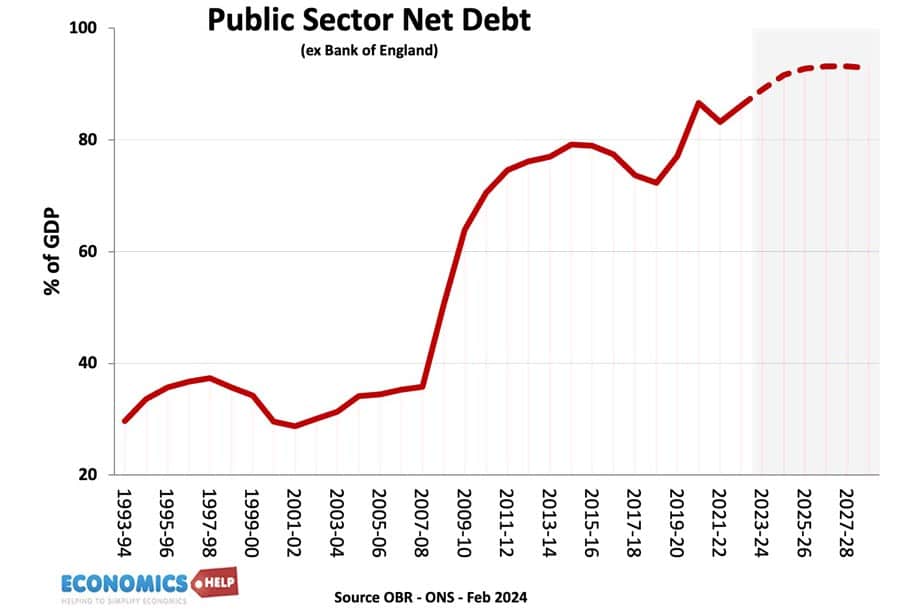
Source: ONS debt as % of GDP – HF6X | PUSF – public sector finances at ONS
Reasons for National debt
- Enables the government to spend more during periods of national crisis, e.g wars, pandemics, and recessions.
- In a recession, the government will automatically receive lower tax revenues (less VAT and income tax) and will have to spend more on benefits (e.g. more unemployment benefits) This causes a cyclical rise in debt.
- Extra government borrowing during a recession can help provide fiscal stimulus to promote economic recovery. By borrowing and then spending more, the government is injecting demand into the economy and this can help to reduce unemployment. This is known as fiscal policy and was advocated by J.M. Keynes.
- Strong market demand for government debt. Private investors buy gilts because they are seen as risk-free investments and there is also an annual dividend from the bond yield. Since 2009, there has been strong demand despite very low-interest rates, meaning the government can borrow very cheaply.
- Finance investment. The government could borrow to finance public investment projects that can lead to higher growth in the future.
- Political convenience. There is usually political pressure to cut taxes and increase government spending. Allowing debt to rise can be a way for the government to avoid difficult choices.
Forecast for the National debt?
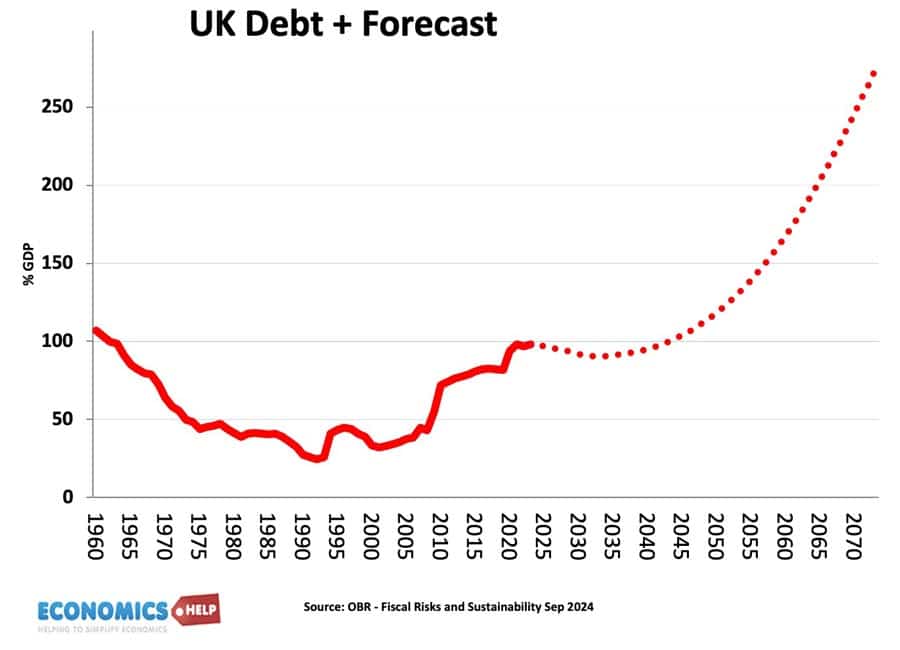
Source: Fiscal risks and sustainability – OBR – Economic and Fiscal Outlook Oct 2024
The OBR have forecast that, on our given trajectory, UK public sector debt could reach 350% of GDP within 50 years. The pessimistic outlook for national debt is made because
- An ageing population and demographic changes will put increased pressure on government spending, notably health care and pension spending.
- A smaller working population will limit UK’s productive capacity.
- Stress on finances from geopolitical events, such as frostier relations with China, Russia and the Middle East.
- Higher energy prices
- Costs of climate change.
- Declining tax revenues from petrol in a decarbonising economy.
- Low productivity growth of UK since the financial crash of 2009
- Recent boost to debt from the financial crisis and one-off cost of Coronovirus pandemic, which cut tax revenues and required government support for lockdown measures.
UK debt in context
Predicting debt for the next 50 years is difficult since we don’t know what kind of productivity improvements may come, e.g. continued gains in renewable energy may reduce the burden of higher oil and gas prices. Equally, the costs of environmental change could be worse.
History of the national debt

Main article: History of UK national debt
UK national debt since 1900
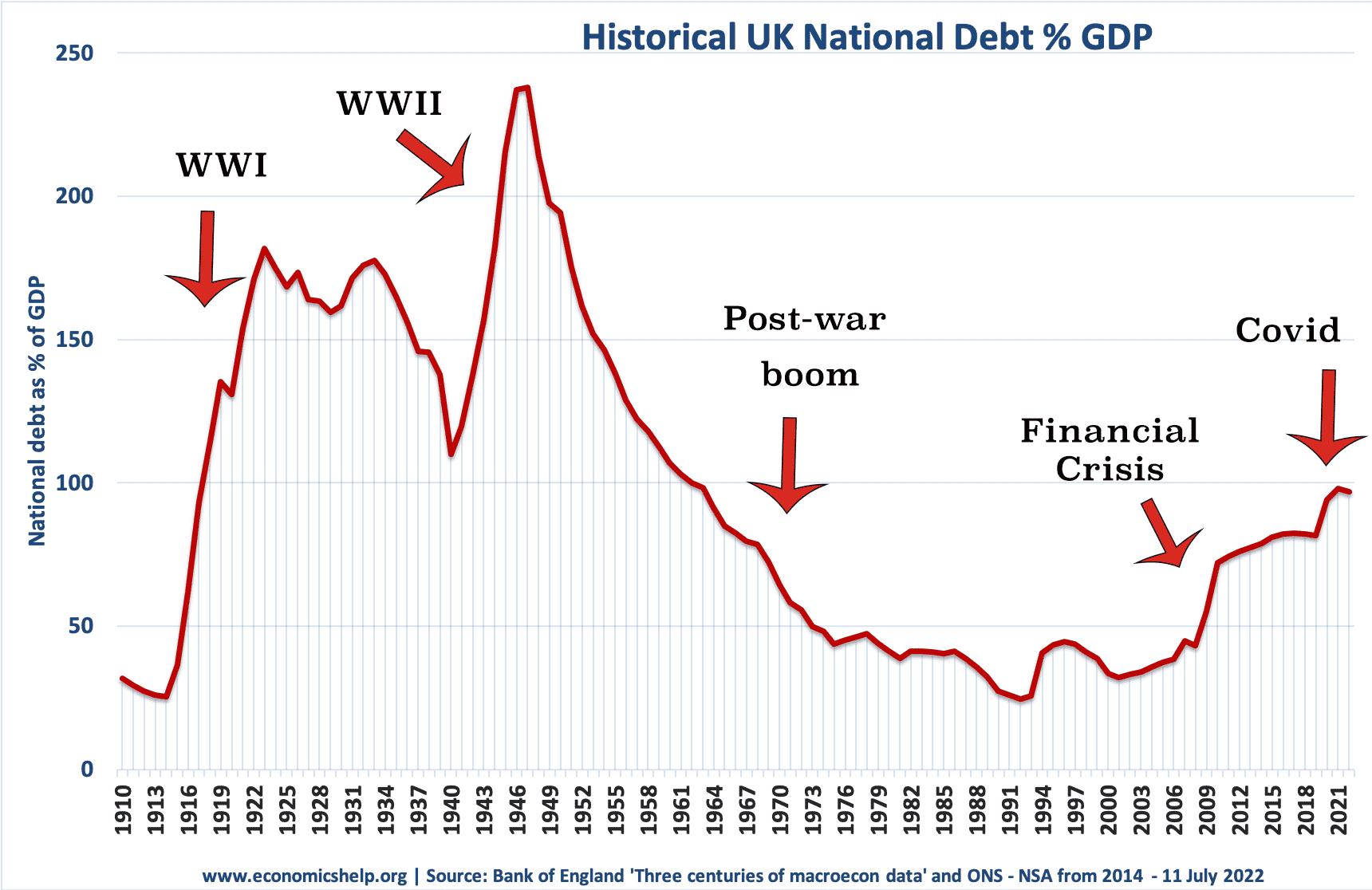
Source: Reinhart, Camen M. and Kenneth S. Rogoff, “From Financial Crash to Debt Crisis,” NBER Working Paper 15795, March 2010. and OBR from 2010.
These graphs show that government debt as a % of GDP has been much higher in the past. Notably in the aftermath of the two world wars. This suggests that current UK debt is manageable compared to the early 1950s. (note, even with a national debt of 200% of GDP in the 1950s, UK avoided default and even managed to set up the welfare state and NHS.
Debt reduction and growth
The post-war levels of national debt suggest that high debt levels are not incompatible with rising living standards and high economic growth.
- The reduction in debt as a % of GDP 1950-1980 was primarily due to a prolonged period of economic growth. See: how the UK reduced debt in the post-war period
- This contrasts with the experience of the UK in the 1920s when in the post First World War, the UK adopted austerity policies (and high exchange rate) but failed to reduce debt to GDP. Debt in Post-First World War period.
Budget deficit – annual borrowing
This is the amount the government has to borrow per year.
- Government
- borrowing in the financial year to December 2024 was £129.9
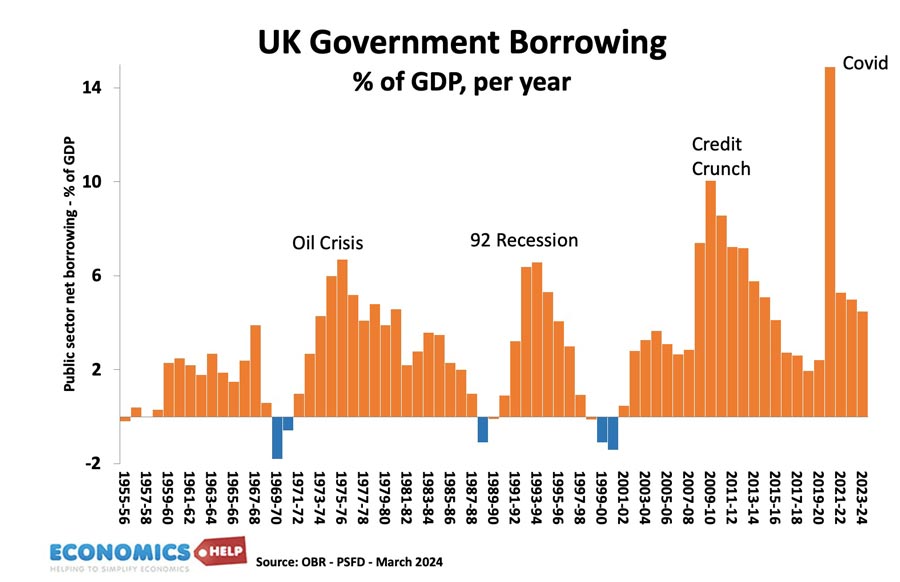
Annual borrowing since 1950. Figures for 2023-24 are forecasts (and rather optimistic!)
Debt and bond yields
Bond yields a the interest that the government pay bond/gilt holders. It reflects the cost of borrowing for the government. Lower bond yields reduce the cost of government borrowing.
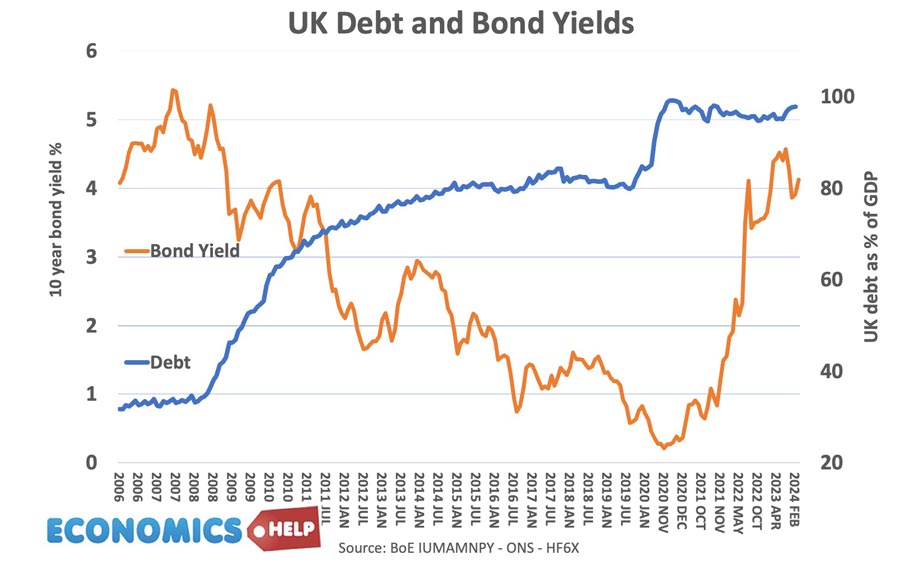
Between 2007 and 2020, UK bond yields fell. Countries in the Eurozone with similar debt levels saw a sharp rise in bond yields putting greater pressure on their government to cut spending quickly. However, being outside the Euro with an independent Central Bank (willing to act as lender of last resort to the government) means markets don’t fear a liquidity crisis in the UK; Euro members who don’t have a Central Bank willing to buy bonds during a liquidity crisis have been more at risk to rising bond yields and fears over government debt.
See also: Bond yields on European debt | (reasons for falling UK bond yields)
Since 2021, bond yields have risen due to pick up in inflation
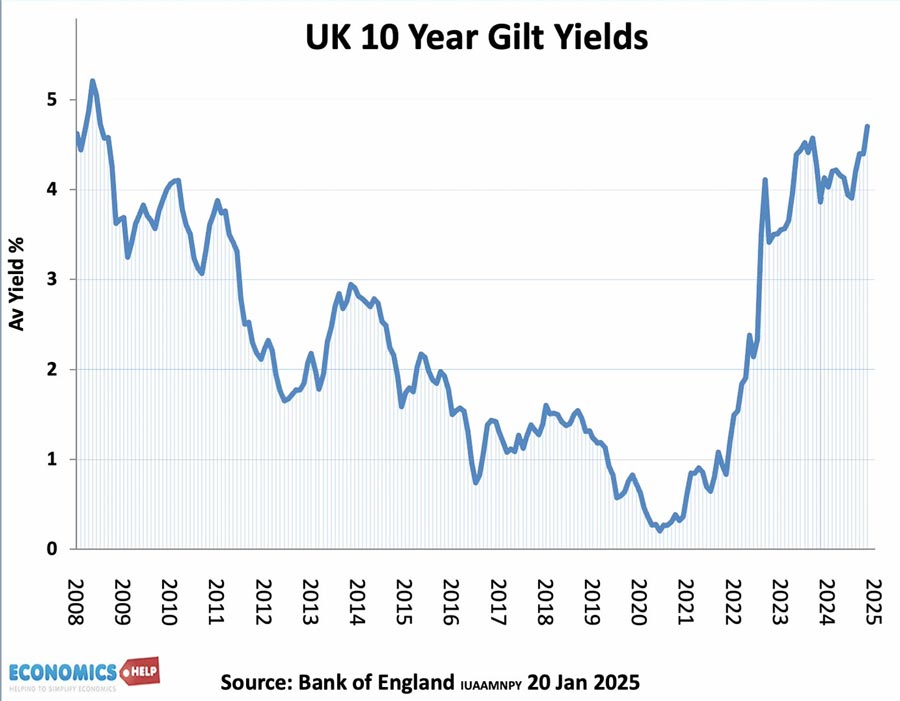
Cost of Interest Payments on National Debt
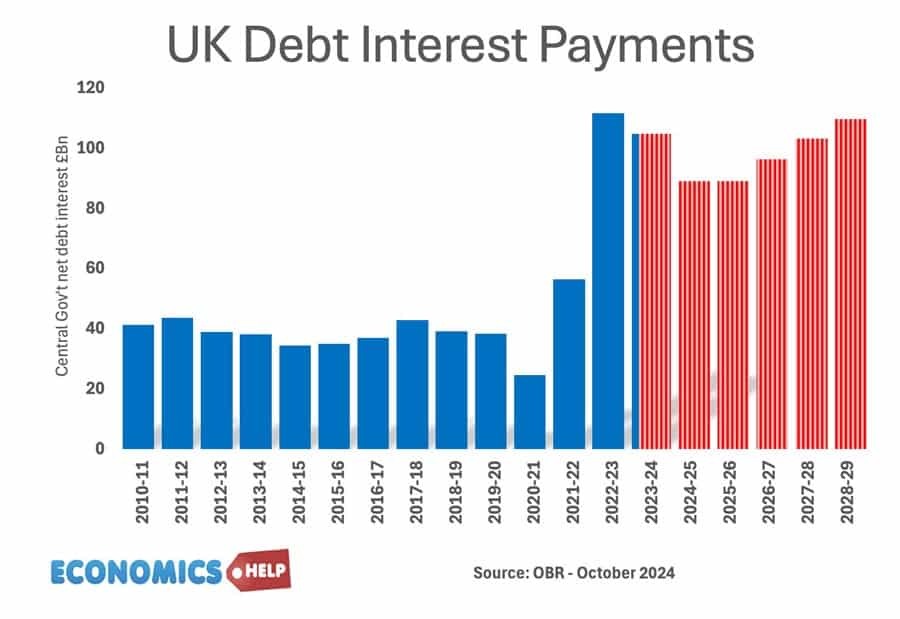
The cost of National debt is the interest the government has to pay on the bonds and gilts it sells. According to the OBR in 2023-24, debt interest payments will be £108 billion. (3.2% of GDP) or 5.2% of total spending. It is lower than in previous decades because of lower bond yields.
See also: UK Debt interest payments
The era of low interest rates post 1992 helped to reduce UK debt interest payments as a ratio of government revenue. However, with interest rates and borrowing increasing – debt interest cost have increased significantly.
Potential problems of National Debt
- Interest payments. The cost of paying interest on the government’s debt is very high. In 2011 debt interest payments will be £48 billion a year (est 3% of GDP). Public sector debt interest payments will be the 4th highest department after social security, health and education. Debt interest payments could rise close to £70bn given the forecast rise in national debt.
- Higher taxes / lower spending in the future.
- Crowding out of private sector investment/spending.
- The structural deficit will only get worse as an ageing population places greater strain on the UK’s pension liabilities. (demographic time bomb)
- Potential negative impact on the exchange rate (link)
- Potential of rising interest rates as markets become more reluctant to lend to the UK government.
However, government borrowing is not always as bad as people fear.
- Borrowing in a recession helps to offset a rise in private sector saving. Government borrowing helps maintain aggregate demand and prevents a fall in spending.
- In a liquidity trap and zero interest rates, governments can often borrow at very low rates for a long time (e.g. Japan and the UK) This is because people want to save and buy government bonds.
- Austerity measures (e.g. cutting spending and raising taxes) can lead to a decrease in economic growth and cause the deficit to remain the same % of GDP. Austerity measures and the economy | Timing of austerity
Who owns UK Debt?
The majority of UK debt used to be held by the UK private sector, in particular, UK insurance and pension funds. In recent years, the Bank of England has bought gilts taking its holding to 25% of UK public sector debt.

Source: DMO Debt Management Report 2022/23
- Overseas investors own about 28% of UK gilts (2022).
- The Asset Purchase Facility is purchases by the Bank of England as part of quantitive easing. This accounts for 26% of gilt holdings.
Total UK Debt – government + private
- Another way to examine UK debt is to look at both government debt and private debt combined.
- Total UK debt includes household sector debt, business sector debt, financial sector debt and government debt. This is over 500% of GDP. Total UK Debt
Private sector savings
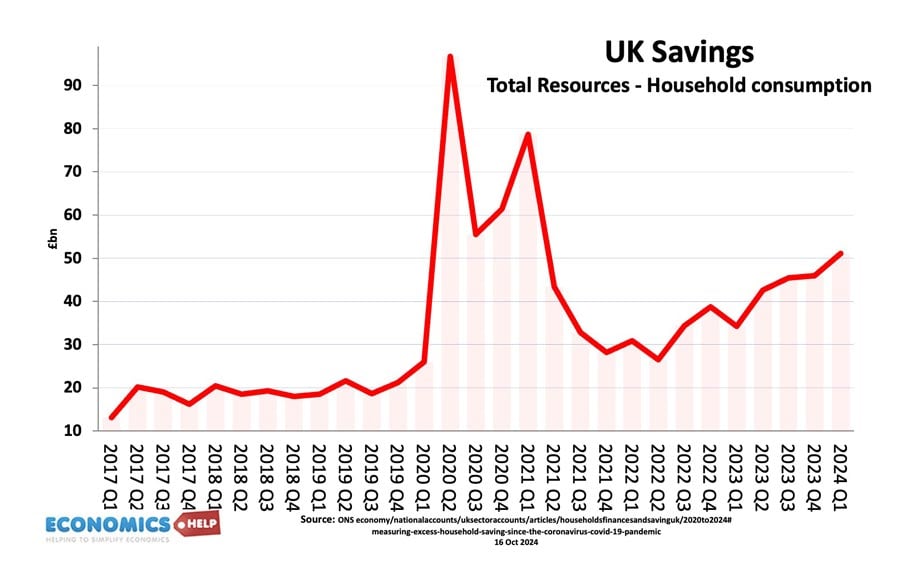
When considering government borrowing, it is important to place it in context. From 2007 to 2012, we have seen a sharp rise in private sector saving (UK savings ratio). The private sector has been seeking to reduce their debt levels and increase savings (e.g. buying government bonds). This increase in savings led to a sharp fall in private sector spending and investment. The increase in government borrowing is making use of this steep increase in private sector savings and helping to offset the fall in AD. see: Private and public sector borrowing
Comparison with other countries
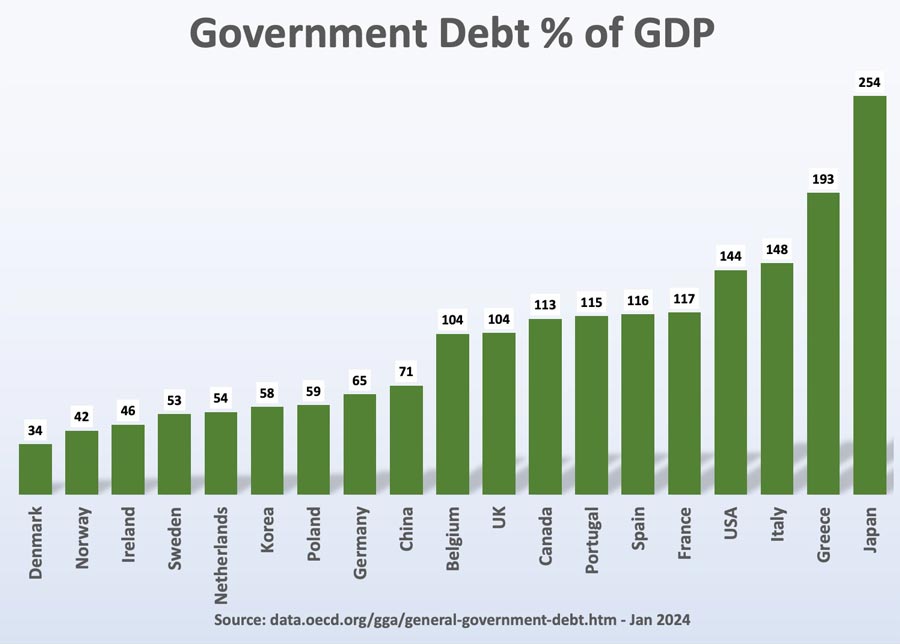
Although 107% of GDP is high by recent UK standards, it is worth bearing in mind that other countries have a much bigger problem. Japan, for example, has a National debt of 256%, Italy is over 157%. The US national debt is over 132% of GDP. [See other countries debt].
How to reduce the debt to GDP ratio?
- Economic expansion which improves tax revenues and reduces spending on benefits like Job Seekers Allowance. The economic slowdown which has occurred since 2010 has pushed the UK into a period of slow economic growth – especially if we consider GDP per capita growth. Therefore the further squeeze on tax revenues has led to deficit-reduction targets being missed.
- Government spending cuts and tax increases (e.g. VAT) which improve public finances and deal with the structural deficit. The difficulty is the extent to which these spending cuts could reduce economic growth and hamper attempts to improve tax revenues. Some economists feel the timing of deficit consolidation is very important, and growth should come before fiscal consolidation.
- See: practical solutions to reducing debt without harming growth
Other countries debt
See also:

Hiya basicly this recession is far from over there far more to come alot more. In 2011 the debt has to start to be paid back which has been put to one side for 2 years with full on borrowing and spending by the goverment labour. People dont relise in 2011 where going to be in for a rough time with the debt needing to start paying it back.
Meaning higher taxes, Spending cuts, Cuts on services and far more things. Which will result in people having less money. Life will get harder and things will not run as they should be and things will be let go in to a state out of control making things go worse.
I’ve watched this recession when it started to now wats happening. I dont trust anything you hear were coming out of recession its complete rubbish. All the jobs lost have not been replaced at all so this shows its alot of rubbish. If you cant replace those jobs lost with new ones it wont get any better.
All the signs are clear to see and hear were in for a rought time and its time people woke up and relised this. You cant keep spending debt when you havn’t payed it back or saved a penny. Because there all in a bubble world and its going to hit them all.
Best thing you can do stay clear of any debt and any borrowing after 2011 if you can avoid it. Because those are the people who are going to feel it big time and people on low incomes as well suffer to which is wrong.
Amazing that some people advocate the lowering interest rates to 0%. This did not help Japan at all with their banking crisis and one can even argue that hyper credit is the cause of the crisis we’re currently facing. You simply cannot lend and spend your way out of the crisis.
which one the the taxes we pay
is used to pay off the uk’s national debt??
How do people who are in debt, now expected to help pay for the national debt, and people not in debt help pay for national debt, I think we are going to be indebted to the Government to getting us all more in debt.
The worlds REAL terrorists are the big corps and bankers. The banks own YOU. They install our leaders, they shape foriegn policy !! If anyone thinks we are “civilised” think again. This is so much more important than economics alone !!! Someone asked above what is the security on gilts ? well is it not the fact that the goverment has 75 million people to tax in a multitude of different ways therefore giving 99% certainty they will honour the debt ? If the two party system looked like it was about to be overthrown by radical changes in the country do you think the Bank Of England would still be as keen to buy gilts ?
“Negative impact on exchange rate”
I presume you mean our currency will fall, to a lower more competetive level…. is the word “negative” the most appropriate to use as it implies this is a bad thing. Every economy has a natural equilibrium exchange rate, trying to manipulate this so as to enjoy the short term benefits of an overvalued currency, will in the long run be counter productive as jobs in internationally tradable occupations are lost.
It seems we are forced to borrow since the top 1% have 17 times as much wealth as the other 99%. The wealth of our nation is created by the vast majority doing a good job, but being paid very little for it, we build roads, hospitals, schools, teach, nurse, deliver goods, still make stuff, cook food… But a few manage to put themselves in a position where they can cream off far more than they can consume, we can’t tax that excess profiteering because the rich will throw their toys out of the cot and go abroad, so government has to borrow the excess income of the top few and lend it back to all the public sector workers to keep providing the wealth they create. Borrowing is unsustainable, so now we are left with the grotesque problem of cutting public spending whilst there is an excess of skilled labour lying idle. Less people working means less wealth being created within the nation, that is not a rational outcome, but is an inevitable consequence of allowing a few to walk away with more than a reasonable share of the wealth we all help create.
One way to regain some of the wealth that has been expropriated is to allow inflation to run ahead of interest rates by printing money. Whilst this would erode the value of cash held by savers, it would encourage holders of cash to find productive ways to protect their cash by buying investing in businesses whose value would be unaffected by inflation. For too long we have been dazzled in the headlights of right wing opposition to inflation, we must understand that low inflation (high real interest rates) serves the interests of the rich, whilst modest inflation with low real interest rates serves the interests of the rest of us trying to earn a reasonable living doing a worthwhile job.
WhAT IS THE NATIONAL UK DEBT PER PERSON?
If it is the Bank of England we owe our debt to, then who owns the Bank of England?
http://www.whatdotheyknow.com/request/bank_of_england_nominees_ltd
http://forumnews.wordpress.com/about/bank-of-england-nominees/
According to this other website our debt is spread amongst national and foreign institutions.
http://www.debtbombshell.com/bond-market.htm
It may be contrary to the zeitgeist to say so but the government got itself into trouble as much by lowering headline taxes as in actual increasing of spending (though it did plenty of that, mainly on capital projects however which are not recurrent costs – other than the PFI ones of course).
Public spending as a %age of GDP in the 2000s was about the same as it was in the 60s, that is, in the 35-40% range – but in the 60s we had high taxes and thus were able to reduce the debt as a %age of GDP – with the assistance of a high inflation rate. In those days the top rate of tax was over 90% – in the US and the UK – and the standard rate was around 40%. Between 1960 and 1970 we were able to reduce our debt from 107% of GDP to 64%.
The conventional wisdom has been – keep inflation and interest rates low and everything will be fine. Hmmm.
The proposed Responsibility office is an interesting idea – but what will be its terms of reference? Will it be like Philip Snowden and go for a balanced budget even it that means all economic activity ceases? Or will it have targets for unemployment, inflation and so on?